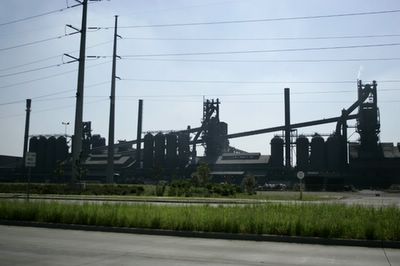
Hazards are in the air for Michigan asthmatics
The Severstal steel plant, formerly Rouge Steel, is one source of soot, which agravates asthma.
Photo taken on August 2, 2005. (The Detroit News/John T. Greilick)
By Gregg Krupa / The Detroit News
The Metro Detroit and Ann Arbor region ranks with places such as the Los Angeles basin and the urban corridor between New York City and Washington, D.C, when it comes to the presence of soot -- tiny, airborne particles of pollution.
But there is concern that the standard the EPA has set for soot is too low. In June, the agency's own scientists advised that the EPA should target smaller concentrations of the particles in the air because they threaten good health -- especially for people who have asthma and cardiovascular diseases.
"A stricter standard is very important, and so is enforcement," said Marie O'Neill, the Robert Wood Johnson Health & Society scholar at the University of Michigan. "If we achieved a really significant reduction in air pollution as a result, you'd see a reduction in hospital visits for asthma, absenteeism for schoolchildren and longer, healthier lives for people."
O'Neill is one of 100 independent doctors and scientists who signed a letter in March urging the agency to regulate lower concentrations of particles in the air.
The EPA uses the measurement of "micrograms per meter cubed" to regulate the amount of particles in the air. Currently, the agency will begin enforcement action -- anything from requiring remedial plans, at first, to fines if goals are not met -- when the 24-hour average limit reaches 65 micrograms per cubic meter and the annual average limit reaches 15 micrograms per cubic meter.
The 100 doctors and scientists urged the agency to lower the thresholds for enforcement to 25 to 35 micrograms per cubic meter for the 24-hour standard, and 12 to 14 micrograms per cubic meter for the annual standard.
Under the Clean Air Act, the EPA is charged with reviewing health standards as frequently as every five years.
"Much new high-quality research into the health effects of particulate air pollution has been completed since EPA's last review of the air quality standards in 1997," the doctors and scientists wrote. "Based on these data, we believe that strengthening of ... the fine particle standards is now needed to protect public health."
Those struggling with asthma say it is easy to notice when the air is cleaner.
"We went to Florida and Georgia and spent about 14 days there recently. My son did not use his inhaler at all," said Yasser Maisari, a pharmacist from Dearborn. "There was a lot of hot air there, and we did a lot of walking."
http://www.detnews.com/2005/health/0509/18/A13-318223.htm

No comments:
Post a Comment